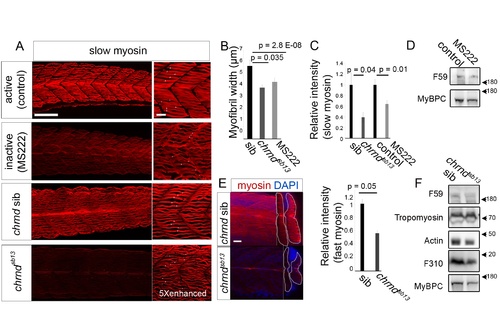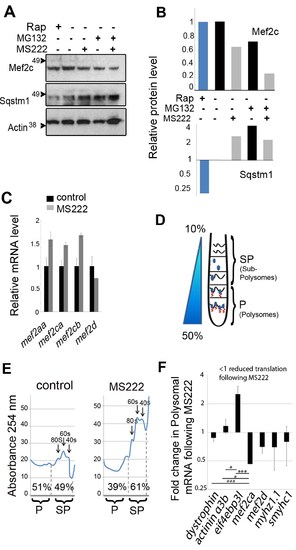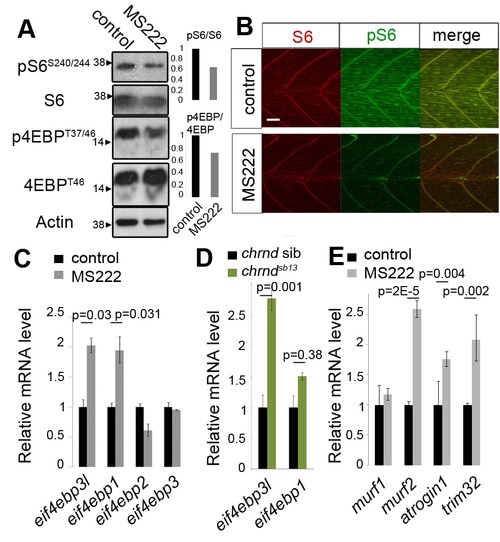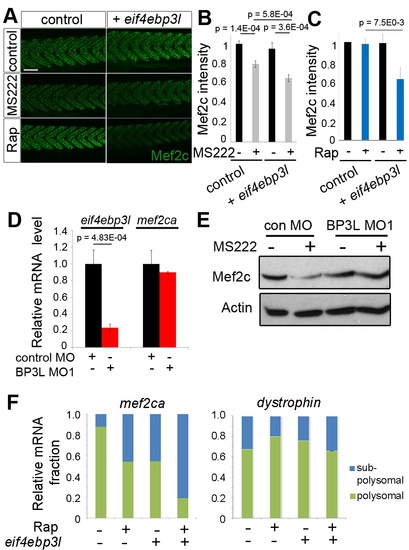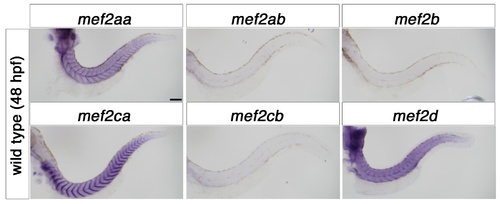- Title
-
eIF4EBP3L acts as a gatekeeper of TORC1 in activity-dependent muscle growth by specifically regulating Mef2ca translational initiation
- Authors
- Yogev, O., Williams, V.C., Hinits, Y., and Hughes, S.M.
- Source
- Full text @ PLoS Biol.
|
Muscle activity enhances zebrafish myofiber width and myosin level. Muscle activity was blocked either by adding MS222 to the fish water for 24chrndsb13/sb13 mutants lacking the acetylcholine receptor delta subunit, which were identified by their immotility. (A) Confocal stacks of slow MyHC immunostaining in 48 hpf embryos. Note the reduced myofibril content and poor bundling in inactive fish. White bars in the right-hand panels indicate minimal myofibrillar bundle width on each fiber. Fivefold more laser light was used to generate the lower right image. (B) Width of myofibrillar material in well-bundled regions of >5 myofibers in somite 17 were measured from >6 embryos in each condition. (C) Slow MyHC level relative to control in n = 15 embryos. (D and F) Western analysis of 48 hpf mutant or MS222-treated embryos, compared to respective controls. (E) Confocal stacks of embryos stained for general MyHC (A4.1025) in lateral (left image) and transverse (right image, somite indicated by white line) view. Graph shows relative MyHC level. n = 10 embryos. Bars represent SEM and samples were compared by t test. All experiments were repeated at least twice. Scale bar = 90 μm in (A, left), (E), and 23 μm in (A, right). |
|
Mef2ca is up-regulated by muscle activity and essential for muscle growth. (A–C) MS222 preferentially suppresses the level of Mef2c protein. Zebrafish embryos were incubated from 31–48 hpf with MS222 and Mef2 and MyoD (A, B) or specifically Mef2c (C) were detected by Western blot (50 embryos/sample). Whereas Mef2 decreased, Myod and Vinculin were unchanged relative to Actin control (B). (D–H) Fibers in the midbody region of wild-type embryos (D) or from a mef2catn213/+ incross (E, F) exposed to MS222 or vehicle for 17 h were immunostained for Mef2c (green) and Hoechst (D) and slow MyHC (E, G) or all MyHC (F, H). Mef2c staining identified mutants at the expected frequency. Myofibril bundle width was determined from at least four fibers in somite 17 of nine embryos in each condition (as shown by white arrows in G). Somite volume was calculated by multiplying the length of the somite 17 by the cross-section area (as shown in red in H, n = 17 embryos). Scale bars = 50 μm. Bars represent SEM and samples were compared by t test. All experiments were repeated at least twice. |
|
Muscle activity regulates translation of mef2ca mRNA. Zebrafish embryos were exposed to MS222, Rapamycin, or vehicle control. (A and B) Muscle activity does not regulate Mef2 protein via the proteasomal or autophagic pathways. (A) Western blot of whole embryos (48 hpf; 50/sample) incubated with 100 nM MG132 or DMSO vehicle for 1 h prior to and then during 17 h MS222 treatment. (B) Quantification of Mef2c and full-length 50 kd Sqstm1 bands relative to Actin. (C) qPCR of the indicated mRNAs relative to actin following MS222 or vehicle (48 hpf 20 embryos/sample). (D) Schematic of separation of cytoplasmic extract on a sucrose gradient into light sub-polysome (SP) and heavy polysome (P) fractions to reveal fraction of mRNA in each. (E) Polysomal profiles of nucleic acid from the gradient of active control and inactive MS222 zebrafish. Peaks indicate 40 s, 60 s subunits, and 80 s monosomes. The amount of nucleic acid in the polysome (P) and subpolysome (SP) fractions were calculated from the areas between the dashed lines. (F) Differential regulation of muscle mRNAs by activity. Proportion of each specific mRNA in the P fraction, SP fraction, and unfractionated (total) was measured by qPCR. Activity-dependent change in translation rate at 48 hpf was determined as the ratio of polysomal/total in MS222 to polysome/total in control (70 embryos/sample). The level of each gene in the fraction was normalized to its level in the total to rule out change in transcription. To present the average from several experiments, the translation change was normalized to the relative change in mef2ca. Bars represent SEM (n = 4) and samples were compared by t test. All experiments were repeated at least twice. |
|
Muscle inactivity down-regulates the TOR pathway and induces eIF4EBP3L mRNA. Wild-type (A–C, E) or chrndsb13/+ incross zebrafish embryos were incubated with (grey bars) or without (black bars) MS222 for 17–24 h. At 48 hpf, embryos were analyzed by Western analysis (A), immunostaining (B), or qPCR relative to actin (20 embryos/sample; C). (A and B) Muscle inactivity reduces TORC1 activity. Phosphorylation levels of downstream TORC1 targets were reduced both in whole embryo (A) and in muscle tissue (B). Scale = 200 µm. Note that both eIF4EBP antisera likely detect eIF4EBP1, 2, and 3L as the epitope sequence is conserved between human and zebrafish (see Figure S4C). (C and E) Electrical inactivity specifically increased eif4ebp3l and eif4ebp1 mRNA in whole embryos (C). Several zebrafish E3 ligase atrogenes showed similar increases in mRNA level (E). (D) Specific loss of muscle activity in acetylcholine receptor δ mutants (identified by their immotility) induces eif4ebp3l, but not eif4ebp1 mRNA, compared to siblings. Actin served as a control (A, C–E) for normalization. Error bars represent SEM and samples were compared by t test. All experiments were repeated at least twice. |
|
Overexpression of eIF4EBP3L reduces and knockdown rescues Mef2c. Zebrafish embryos injected with RNA encoding eIF4EBP3L (A–C, F) or control MO or BP3L MO1 (D, E) were grown to 48–54 hpf and some exposed to MS222 for the last 17 h (A, B, E) or to 5 μM rapamycin for 6 h (Rap; A, C, F) or remained as untreated controls. (A–C) Mef2c immunostaining intensity quantified by confocal microscopy in 54 hpf embryos shows that overexpression of eIF4EBP3L reduced Mef2c protein in inactive (B) or rapamycin-treated (C) muscle. n = 60 (B) and n = 20 (C) embryos/sample. Scale bar = 90 μm. (D) Level of indicated mRNAs assayed by qPCR shows that BP3L morphants have reduced eif4ebp3l mRNA. (E) Western analysis shows that BP3L MO1 prevented decrease in Mef2c caused by inactivity compared to actin loading control. Bars represent SEM. Samples were compared by t test. All experiments were repeated at least twice. (F) Polysomal fractionation followed by triplicate qPCR for mef2ca and dmd mRNAs on polysomal and subpolysomal fractions. EXPRESSION / LABELING:
|
|
Active eIF4EBP3L regulates myofibrilogenesis following inactivity. Embryos were injected with the indicated MO, some exposed to MS222 for the last 17(A) or with plasmid DNA encoding a constitutively active eIF4EBP3L and GFP (5A3L-GFP) or empty vector (GFP) (B) were grown to 48–54 hpf and immunostained for slow MyHC. (A) BP3L MO1 prevents, and BP3L MO2 reduces, the decrease in slow MyHC caused by inactivity. Immunostaining (left panels) was quantified by confocal microscopy (right panel; n = 15 embryos/sample). (B) Overexpression of 5A3L reduces myofibril bundle width. Following heat shock, the size of slow myofibril bundles in GFP+ fibers was determined relative to their GFP neighbors (n = 9 embryos/sample). Bars represent SEM and samples were compared by t test. All experiments were repeated at least twice. Scale bar = 23 μm. |
|
chrndsb13/sb13 mutant lacks acetylcholine receptors. Zebrafish chrndsb13 mutant 48 hpf embryos were stained with α-bungarotoxin-Alexa Fluor 555 (Invitrogen), which binds to the acetylcholine receptor. Note the lack of signal in mutant at both neuromuscular junction (arrows) and myotendinous junction (arrowheads). Bar = 40 μm. |
|
Three Mef2 mRNAs accumulate in 48 hpf muscle. In situ mRNA hybridization for mef2 family members in 48 hpf zebrafish trunk and tail. EXPRESSION / LABELING:
|
|
Inactivity reduces myofibrilogenesis more significantly than rapamycin. Zebrafish embryos were treated with MS222, rapamycin, both, or vehicle control from 31–32 hpf and analyzed at 48 hpf. (A) Immunofluorescence of slow MyHC on whole-mount embryos treated with either MS222 or rapamycin for 17 h. Note that brightness was enhanced on MS222 image to show myofibril bundles. (B) Effect of rapamycin on pS6 immunoreactivity in muscle. (C) Quantification of slow fiber myofibril bundle width. Mean ± SEM (n = 8 embryos in each condition, 10 fibers measured per embryo). (D) Western analysis of Tropomyosin, Actin, and Fast MyLC in the presence of MS222, rapamycin, or both. |
|
Zebrafish eIF4EBP3L is a conserved eIF4EBP induced in inactive skeletal muscle. (A–C) Comparison of human and zebrafish eIF4EBPs using MegAlign Jotun-Hein method (DNAstar v10, Lasergene) to align eIF4EBP sequences from ENSEMBL Zv9 and Hu GRCh37. (A) Tree view from MegAlign. (B) Amino acid identity and diversity between human and zebrafish eIF4EBPs. (C) Alignment of human and zebrafish eIF4EBPs. TOR phosphorylation sites are marked with red arrows, eIF4E binding site with black line, and residues mutated in 5A3L are marked red. (D) Expression of zebrafish eIF4EBPs at 48 hpf by in situ mRNA hybridization. Top row shows expression in head; middle row in somites; bottom row in somites of sibling embryos treated for 24 h with MS222 revealing a tissue-specific increase in eif4ebp3l mRNA. Arrow indicates previously described eif4ebp3 pancreas expression. Bars = 200 μm. EXPRESSION / LABELING:
|
|
Overexpression of eIF4EBP3L in zebrafish. (A) Levels of overexpression of eif4ebp3l are within the physiological range. In situ RNA hybridization (upper panel) and qPCR quantification (lower panel) at 48 hpf of embryos injected with eif4ebp3l RNA. (B) No obvious effect of overexpression of constitutively active eIF4EBP3L (5A3L) on nonmuscle cells. Zebrafish embryos were injected with plasmid encoding a heat-shock-driven 5A3L-IRES-GFP. Following heat shock and BODIPY incubation, embryos were scanned live. Control GFP-negative cells are outlined in epidermis to show similar size. |

